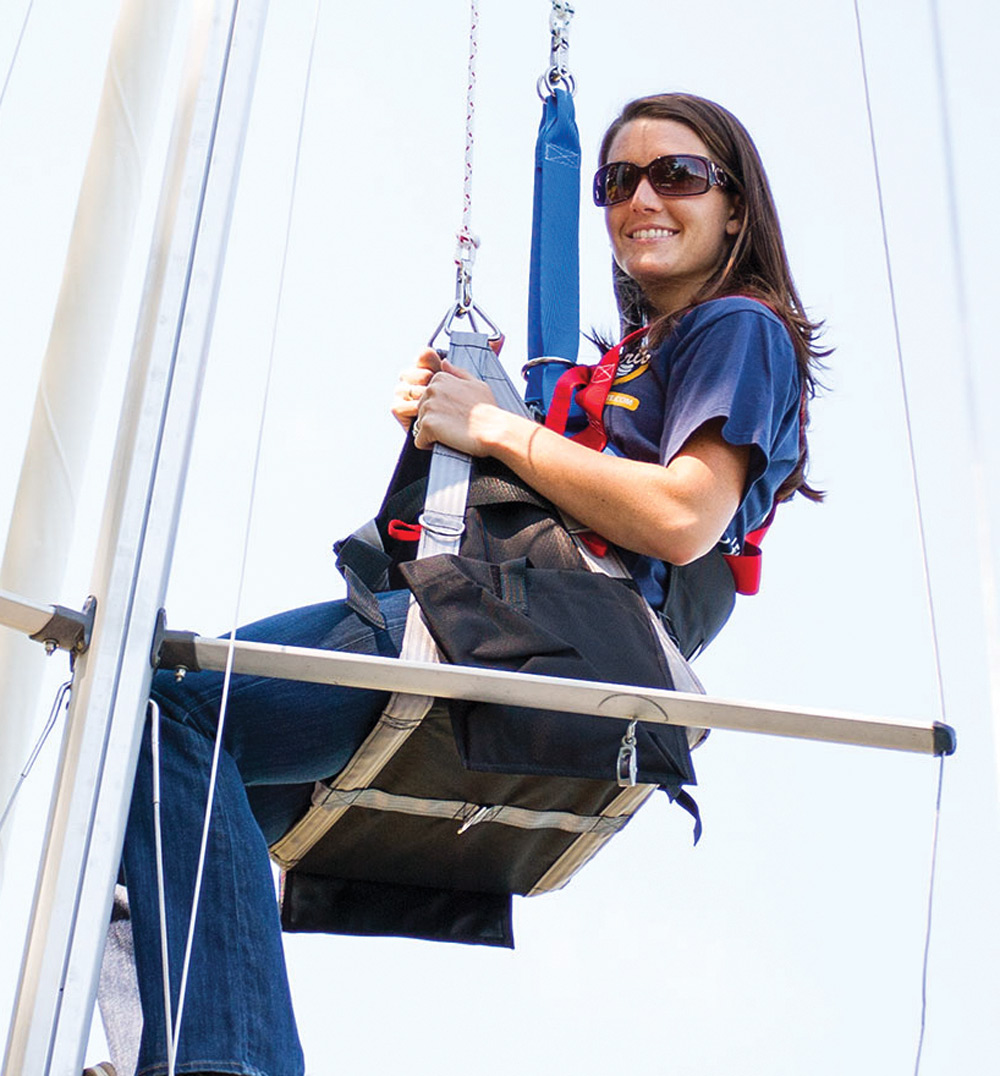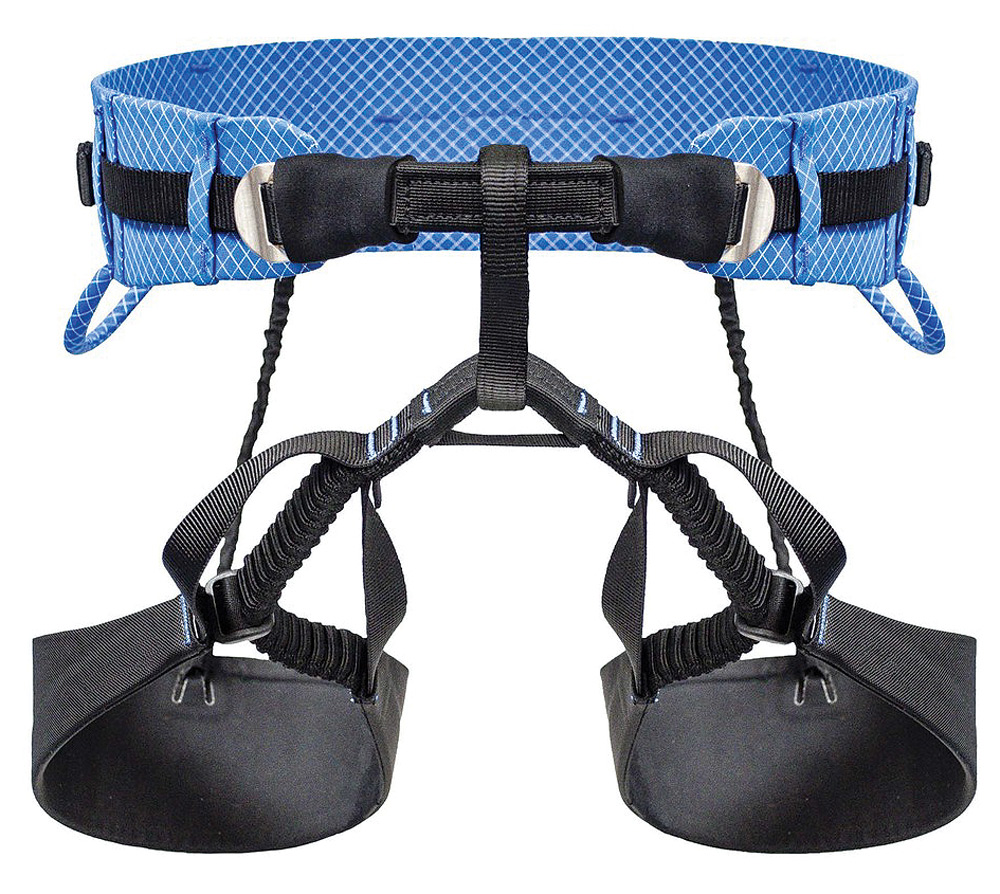Going aloft
Whether you have help or you’re going solo, a trip up the mast starts with safety
There are times on every boat when you need to send someone aloft. This is almost never convenient, but it’s a necessity and one in which safety needs to be a priority. Fortunately, the days of a plank bo’sun’s chair are gone and new techniques and equipment makes the whole ordeal less trying.
When going aloft, the most important piece of equipment is the chair or harness. You want one that you cannot fall out of, even if you find yourself inverted. Ideally it should be comfortable too, with good back support and enough bearing surface on your legs to keep circulation going. Depending on how you are built, a chest harness can be helpful to keep you upright.

A traditional seat like the one made by Harken Canvas is comfortable, but the large seat is a little bulky depending where you are working. The backrest and crotch strap keep you comfortable. The attachment point is high, providing stability but limiting how high you can get on the mast. Be sure to check the weight capacity on whatever you use; Harken’s chair is rated for a maximum of 220 pounds.
Another option is a climbing harness, and although they are not as comfortable as a chair they have several benefits. The security of a harness is unmatched; you cannot fall out of one, even if you would be knocked unconscious. This makes a harness better for going aloft underway, when the safety of a slightly more uncomfortable setup is worth the tradeoff. The attachment point is fairly low as well, allowing you to easily reach the masthead when hoisted all the way up. Brion Toss Yacht Riggers sells a beautiful climbing harness, purpose-built for the marine market for $425. You can find cheaper climbing harnesses, but they are unlikely to be as robust and comfortable.
Spinlock also makes a mast harness that sells for $159.
Regardless of the chair or harness you choose, the bigger issue can be how to get up the mast in the first place.
The easiest method is to find someone to grind you up, but this comes with risks. This is someone who is in charge of the life of the person going aloft, so they need to be adept at line and winch management, know exactly what is happening and be strong enough to grind a winch for a long time. It is best to have two people: one to grind and another to tail (even through the self-tailer) and to watch the person going aloft at all times.
The halyard on the winch should be secured when the person aloft is at his or her highest point. You can do this by tying a hitch back on the taught halyard before the winch, always leaving the line in the self-tailer as well. It’s a good idea to do this even if the halyard is run through a rope clutch; you can’t be too careful. Fake out the line so it runs smoothly when it’s time to let the person down.
When it’s time to ease the person aloft down, it’s helpful again to have two people: one to ease the halyard and one to watch aloft and call out the person’s location so the halyard minder can slow up when they are navigating past the spreaders. The motion should be smooth; the person aloft will not appreciate a herky-jerky ride down.
It’s also a good idea to go up on two halyards, just in case. The main one will haul you up and second as a safety in case the first one would fail. Never trust shackles, especially snap shackles, for attachment. Instead, tie the halyard to the chair or harness using a bowline or appropriate climbing knot. A short tether to attach to the mast can add some security and will prevent you from getting too far from the mast should the boat be pitching around.
If need be, there are ways to haul yourself aloft, even if you are not particularly strong. A 2-to-1 tackle hoisted to the masthead will allow you to haul yourself pretty easily. Due to the nature of the mechanics of the setup, you only need to pull 25% of your weight. Depending on your weight this can be a lot, and you can’t underestimate how many pulls it will take—it can be a long way up. Your best bet is to have a helper on deck to belay the line for you and make sure it doesn’t tangle on anything. If you have a helper, it would be an even better idea to have them grind the line for you. It will take twice as long to grind you up—the line is double in length—but it will be much easier with the 2-to-1 tackle.

An even better way to climb on your own is to borrow from the climbing world and “frog” up the mast. This technique involves a harness, foot loops and a pair of ascenders. An ascender is a mechanical device that you can freely slide up the rope, but will mechanically lock when pulled in the opposite direction. The system is setup with an ascender attached to each the harness and the foot loops, and both ascenders are threaded onto a taut halyard. The climber starts out sitting in the harness with his feet in the foot loops. He pulls his feet up and slides the foot ascender up the rope. Next, he stands up on the foot loops and slides up the seat ascender. This action is repeated all the way to the top. It sounds complicated but you can develop a pretty fast rhythm and get up the mast quickly. Coming back down is just as easy, you just reverse the process. It’s easier than it sounds but does take some practice.
You can assemble your own climbing gear to frog up the mast or you can buy a ready made set up from ATN. Its Mastclimber includes a hybrid harness-chair, ascender and foot loops. If you have been to a boat show in the last few decades you have certainly seen the Mastclimber demonstrated.
The system is made from robust climbing-quality webbing, sewn at all the terminations. They are stainless steel and designed to be fully captive on the halyard, but they do come apart to allow you to fit them onto the halyard. These ascenders are ATN’s design but manufactured by CMI, the leader in ascenders. ATN’s harness is a hybrid, it has a rigid seat for comfort, with a wide backstrap, and a crotch strap to keep you in place.
The ATN system does allow you to get fairly close to the masthead and if you stand up in the foot loops at the top of the mast you can even get your head and shoulders well above the masthead. Standing in foot loops does take some practice to keep firm footing though.
If you choose the Mastclimber or any frogging system, get some practice before you need to really use it. It’s a good idea to take your gear to a climbing gym. The gym personnel can help coach your technique, and you’ll be in a safe, supervised environment.
The final option is permanently mounted mast steps. Even if you have these, you should use a harness and have someone tail you up. Second, steps may seem as easy as climbing a ladder, but don’t underestimate the awkwardness of climbing a perfectly vertical moving ladder. I would highly recommend folding mast steps, this will keep the snagging and windage of fixed steps to a minimum.
Folding mast steps have been around forever but the designs have been lacking in my opinion. Plastic steps make me nervous, especially considering UV exposure and aluminum steps tend to rattle. I recently discovered a new step design from Lunar Marine. Lunar makes a very high-quality folding aluminum step. The step is machined from billet 6061 aluminum with a titanium pivot pin. The entire step and pin are tumble polished and hard-coat anodized, giving it a really nice finish, ensuring no corrosion or issues with dissimilar metals. The step is held closed when folded with two high-strength magnets, making sure it won’t rattle or pop open at the wrong time. When folded the steps have a very low profile, but are more than 5 inches wide when open and have an aggressive nonskid pattern machined into them.
I like all of these systems and have incorporated a bit of each into my solution. I use Brion Toss’s harness as the core of my solution—you can find no better harness for mast climbing. I will typically find some buddies that I trust to grind me up but when I can’t, I rely on ATN’s system. You can buy the ATN Mastclimber system without the harness, and my Brion Toss harness shackles right in place.
I also like a pair of mast steps at the top of the mast. The steps allow me to work at the masthead and have firm footing on the steps. The steps just about disappear when folded. I added a couple mast steps at the base of the mast as well because the height of the boom and mainsail stack make it difficult to reach the head of the mainsail to attach the halyard. A couple steps are much easier and safer than climbing up on the winches.
There is no perfect system for going aloft, but sometimes it must be done. Taking time to do proper safety checks before anyone leaves the deck is the most important step.
Sources:
Harken Canvas, www.harkencanvas.com; Brion Toss Yacht Riggers, www.briontoss.com; Spinlock, www.spinlock.co.uk; ATN, wwww.atninc.com; Lunar Marine, www.lunarmarine.com

Comments